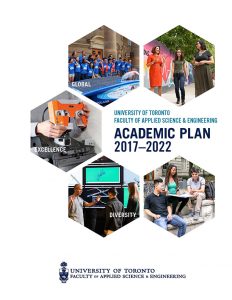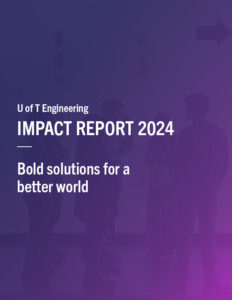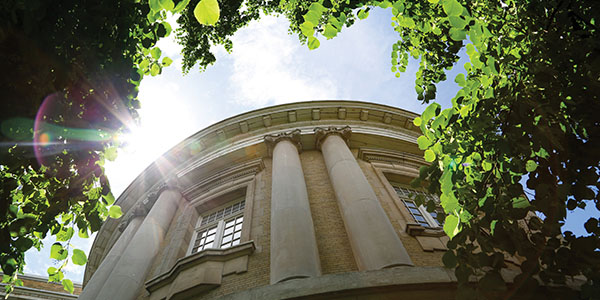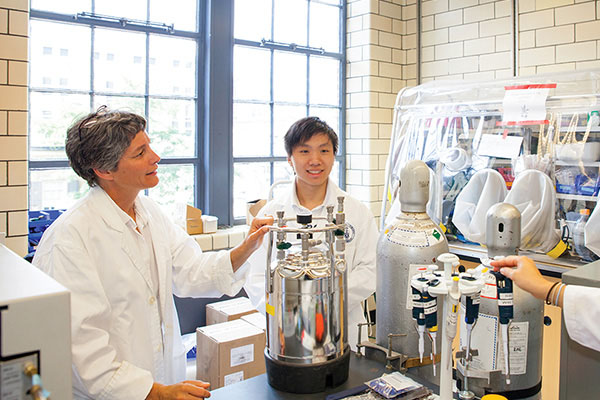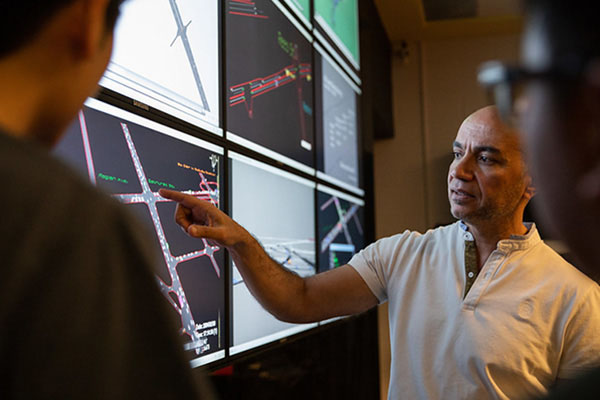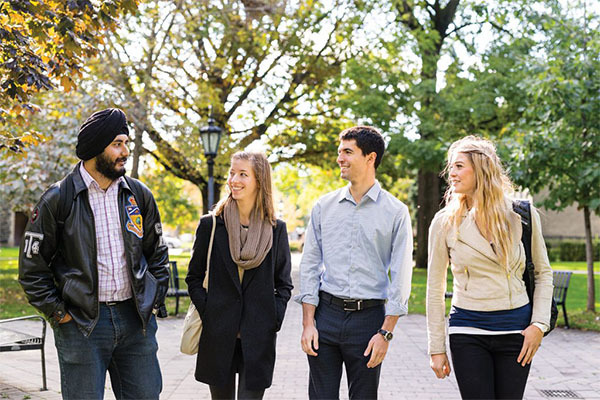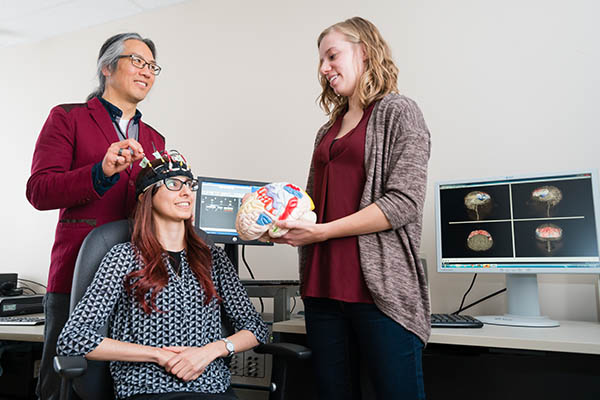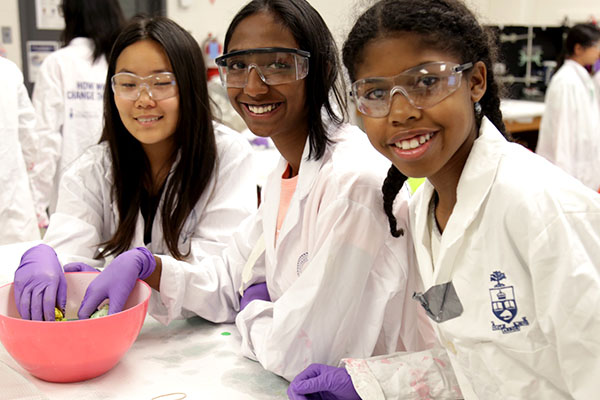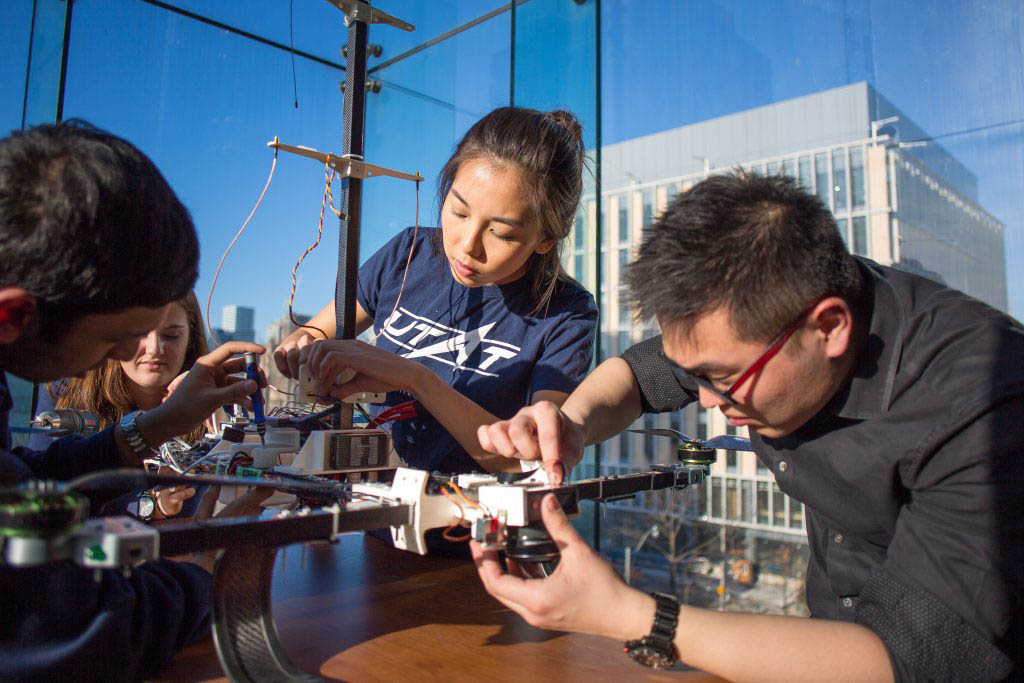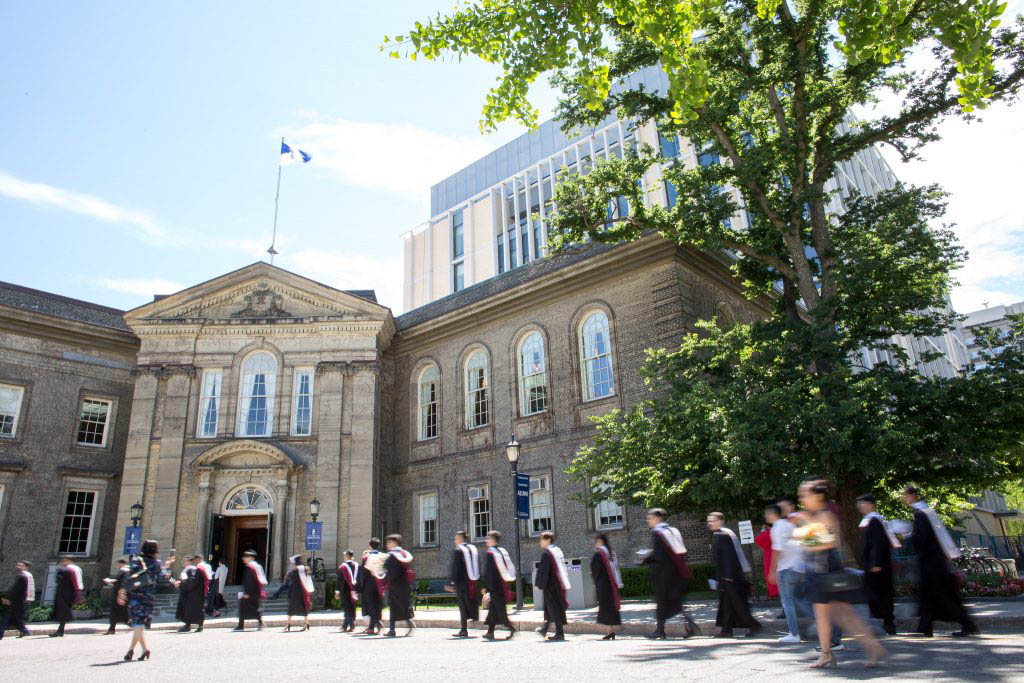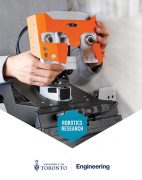From exploring the depths of the ocean to roaming the surface of Mars, robots enable us to tread where it is otherwise too dangerous for humans to go. With advances in artificial intelligence, robots are also finding a niche in our day-to-day lives: they are helping to care for our elderly, delivering goods to our doorsteps and assisting doctors with performing surgery.
U of T Engineering has the largest and most diverse robotics program in Canada with more than 55 researchers and seven Canada Research Chairs in the area of robotics. We are using machine learning to build self-driving vehicles, autonomous flying robots and robotic retrofits for assistive devices such as wheelchairs. We are designing miniature robots that can travel in teams, and even swim through the human bloodstream. We are also building new human-machine interfaces to make programming and interacting with robots more effective and intuitive.
Together with a range of strategic industrial partners including IBM, Toyota, Hitachi High-Tech, Samsung, MDA and Telus, we are ushering in a future where robots will extend human capabilities and improve lives.
RESEARCH CENTRES & INSTITUTES
-
2019: U OF T ROBOTICS INSTITUTE
The U of T Robotics Institute is the central headquarters for world-leading robotics research and education across U of T. Focused around three research pillars — autonomous field robotics, health-care robotics and manufacturing robotics — this institute will promote high-impact industry and academic partnerships.
-
2015: CENTRE FOR AERIAL ROBOTICS RESEARCH & EDUCATION (CARRE)
CARRE is preparing engineers and scientists with the interdisciplinary expertise needed to contribute to the growing field of aerial robotics. Applications include environmental monitoring, delivery of goods and even sound and light displays.
-
2014: TORONTO INSTITUTE FOR ADVANCED MANUFACTURING (TIAM)
TIAM expedites the research and development of advanced manufacturing technologies by creating a multidisciplinary network focused on sharing knowledge, ideas and resources. The Institute demonstrates global leadership by translating lab-based technologies into commercial, scaled-up processes and by contributing to the education of highly qualified personnel in the manufacturing sector. Read more about TIAM.
-
2010: INSTITUTE FOR ROBOTICS & MECHATRONICS (IRM)
IRM brings together more than 50 principal investigators from across U of T Engineering and the Department of Computer Science to create the next generation of intelligent and autonomous robots for use in a variety of sectors: health care, exploration, rescue, security and more.
EXPERTISE
Selected areas of expertise in robotics research at U of T Engineering
- Advanced Manufacturing
- Aerial Robotics
- Artificial Intelligence
- Assistive Robotics
- Autonomous Vehicles
- Human Factors and Transportation
- Machine Learning
- Microrobotics
- Nanorobotics
- Personal Robotics
- Rehabilitation
- Robots for Society
- Surgical Robotics
RESEARCH IMPACT
Helping robots see
From defusing a bomb to exploring distant planets, some jobs are high-risk or even impossible for humans. There is immense potential for autonomous, mobile robots to take on these dangerous roles, protecting human life and allowing us to explore places never before thought possible.
Professor TIM BARFOOT in the University of Toronto Institute for Aerospace Studies is helping mobile robots navigate their surroundings. His team pioneered a navigation algorithm called visual teach and repeat (VT&R), which allows a robot to repeat a route that it has travelled without a GPS and using only a single camera. Imagine a robot reaching a dead end inside a long canyon — with VT&R, it can simply backtrack the way it came and try a different route.
Visual navigation is especially useful in scenarios where there is no accurate, global map — like on a distant planet — but it is difficult to deploy in the long-term because of the potential for changes in the landscape. In Canada, for example, many streets look completely different between winter and summer.
Barfoot’s team is now addressing these challenges. Working with industry partners like Clearpath Robotics and MDA, they are creating robots with visual systems that can deal with changes in lighting conditions, changes in landscape, and the presence of other moving objects. This technology will have applications in transportation, planetary exploration, mining, warehouses and military scenarios.
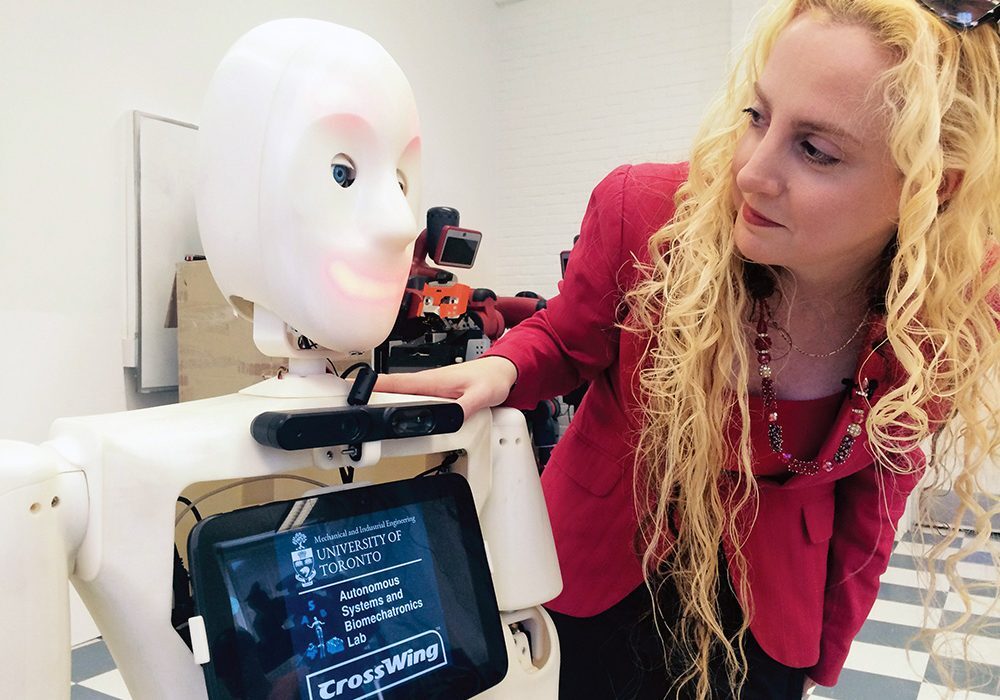
Robots for Society
Our aging population needs quality care, including programming that encourages cognitive stimulation, social engagement and independence. As large numbers of health-care professionals retire, growth in our aging population is putting a strain on health- care systems to provide these much-needed services.
As the Canada Research Chair in Robots for Society, mechanical engineering professor GOLDIE NEJAT is developing a suite of assistive robots that can address these challenges. Her lab is home to Tangy, an autonomous robot that can facilitate bingo and trivia games for groups, and Casper, a robot that assists with the daily activities of older adults with cognitive impairments including dementia. Other robots, such as Brian and Leia, are expressive robots learning to recognize human body language, vocal intonation and facial expressions to engage in more natural assistive human-robot interactions.
Another focus of Nejat’s lab is robot-assisted emergency response. In urban search and rescue operations, time is of the essence. Rescue robots need to be able to effectively search an unknown environment looking for trapped victims as efficiently as possible. Nejat and her group are developing a team of collaborative mobile rescue robots that can learn to coordinate their actions and interact effectively with humans in order to meet the needs of the mission.
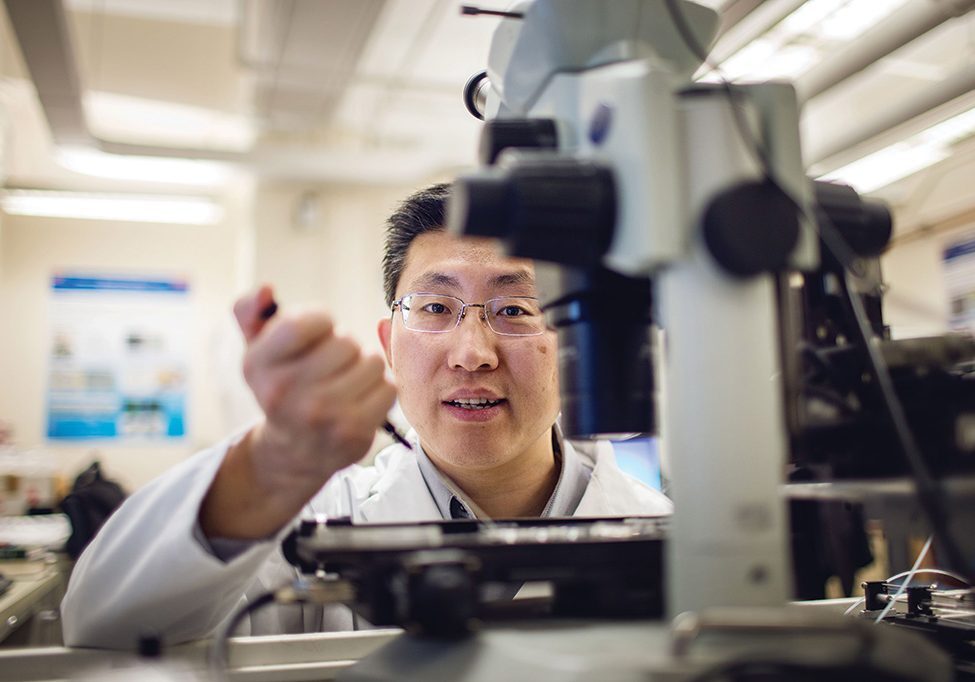
Micro- and Nano-robotics for medicine
The ability to sense and manipulate individual cells — or even smaller structures like chromosomes and proteins — could be very useful in medical procedures such as disease diagnostics, drug screening, and clinical cell surgery. Miniature robots offer solutions.
Mechanical engineering professor and Director of the U of T Robotics Institute YU SUN holds the Canada Research Chair in Micro and Nano Engineering Systems. He and his team are developing micro- and nano-robots to address challenges in the robotic manipulation of cells and sub-cellular structures. One of their cell-surgery robots uses artificial intelligence to select a single sperm cell with high DNA integrity and insert it into an egg cell for patients experiencing infertility.
Other robots developed by Sun and his team are capable of drilling into a cell’s nucleus to extract specific strands of DNA or measuring communications between thousands of cells for drug screens and personalized heart failure therapeutics. They also have robots that rapidly test mechanical and electrical characteristics of individual cells for distinguishing cancer cells from non-cancerous ones in patient samples.
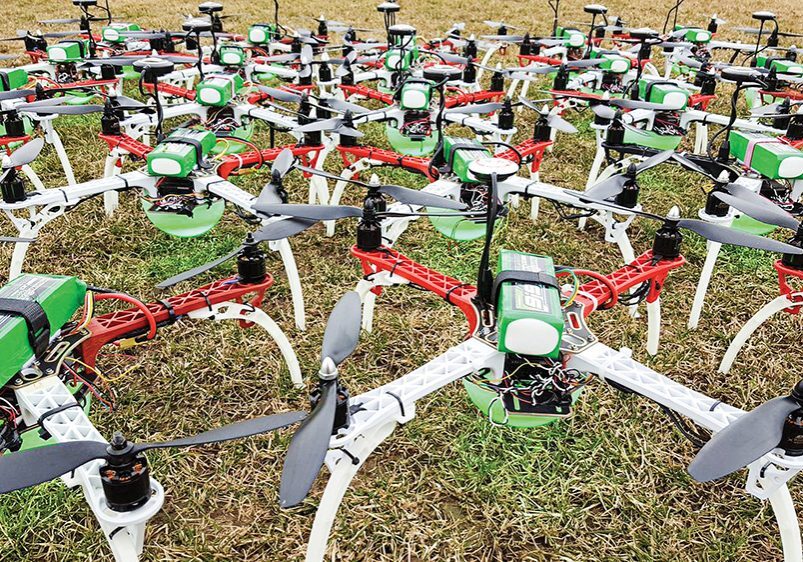
Flying robots for all occasions
Fireworks are popular for celebrations, but they pose a significant fire hazard and can leave behind a legacy of toxic particles that linger in the air long after the display is over.
Arrowonics has a more sustainable solution. Founded by aerospace engineering professor HUGH LIU, the company uses dozens of networked drones to create impressive sound-and-light displays for festivals and other public events. Arrowonics includes several of Liu’s former graduate students, including CEO EVERETT FINDLAY. Findlay and his team have designed the algorithms needed for the drones to communicate with each other and fly in complex formations without colliding.
Over the past year, Arrowonics has produced shows across Canada, including on Victoria Day and Canada Day. They also recently opened their first U.S. operation, and performed in Kuwait City to celebrate the opening of the newest Four Seasons hotel.
Other UofT Engineering research focuses on similar application for other types of robots, including wheeled vehicles. Professor ANGELA SCHOELLIG and her team are developing techniques that can keep self-driving robots safe while learning new tasks. She is also supervising a team of students who are working to make an electric car into a self-driving one as part of AutoDrive, an international collegiate competition.

“Robots are a powerful way for humans to go places we currently can’t, from inside the human body to the furthest reaches of space. Roboticists at U of T are pushing the boundaries of what is possible.”
PROFESSOR YU SUN
Director, U of T Robotics Institute
THE FUTURE OF ROBOTICS
Aerial monitoring to improve mining operations
On mine sites, rocks are drilled, blasted, ground up and moved around on an enormous scale. While managers do their best to monitor their operations, they are often limited to taking measurements at particular locations or points in time; the full picture remains elusive.
Drones offer a way to monitor a large area more efficiently than manual inspections or remote sensors. Using an NSERC Collaborative Research and Development grant, mineral engineering professor KAMRAN ESMAEILI and aerospace engineering professor ANGELA SCHOELLIG are partnering with McEwen Mining Inc. to develop a system that can provide a bird’s eye view of mining operations. Images captured by the drones can be analyzed to provide precise information about the effectiveness of rock fragmentation, quality control of blasting, ore dilution and other process steps.
By providing rich data to mine managers, these robots can help them make better decisions, resulting in safer and more efficient, economic and environmentally-friendly mine operations.
A new generation of drone experts
Drones are giving rise to an entire industry of hardware and software manufacturers that can offer solutions to a wide variety of situations, from search and rescue to monitoring the spread of forest fires.
U of T Engineering professor HUGH LIU leads the Research and Training Program in Unmanned Aerial Vehicles. Funded by an NSERC Collaborative Research and Training Experience grant, the program aims to educate 150 new experts in the use of unmanned aerial vehicles (UAVs). These graduates will drive the expansion of drones into new areas, such as helping farmers keep track of their crops or monitoring environmental changes in Canada’s north.
SPECIALIZED EDUCATIONAL OFFERINGS IN ROBOTICS
Our Master of Engineering students can choose from a wide range of technical emphases, including Robotics & Mechatronics and Advanced Manufacturing. Engineering undergraduates can complement their studies with minors in Robotics & Mechatronics, Advanced Manufacturing and Nanoengineering. Engineering Science students can major in Robotics as well as Machine Intelligence -- the first program of its kind in Canada.
LATEST ROBOTICS STORIES
OUR INNOVATION CLUSTERS
U of T Engineering has the breadth and depth of research excellence as well as the capacity to effect global change across these key domains.
OUR EXPERTS
Find the U of T Engineering researchers with the expertise to solve your most complex challenges

LEADING INNOVATION STARTS HERE
DOWNLOAD PDF
Connect with us to discuss how a partnership with U of T Engineering can benefit your organization.

